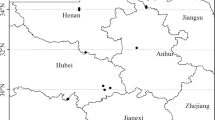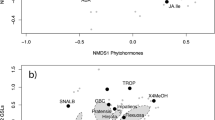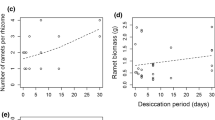Abstract
Evaluation of biotic interactions along geographic gradients reveals that pressure on plant populations by herbivores and pathogens increases as latitude decreases, and is accompanied by a parallel increase in the number and toxicity of alkaloid-bearing plants. We compared rhizome alkaloid content with plant reproductive and vegetative characters in Sanguinaria canadensis (Papaveraceae) along an elevational gradient over two growing seasons to ascertain 1) if alkaloid production in bloodroot varies among populations and systematically with elevation, and 2) if there exists a correlation between isoquinoline alkaloid, vegetative and reproductive production. In general, alkaloid content in bloodroot rhizomes declines with elevation, increases with rhizome water content, varies by site, and fluctuates seasonally with plant growth and reproduction. Alkaloid content was positively correlated with vegetative and reproductive effort with few exceptions. Analysis of total protopine and benzophenanthridine alkaloid concentrations revealed generally similar patterns as those of individual alkaloid concentrations, although significant differences did appear between individual alkaloid concentrations.
Similar content being viewed by others
REFERENCES
ANONYMOUS. 1996. Statistical Analysis Software. Version 6.12. SAS Institute, Carey, NC.
AGRESTI, A. 1996. An Introduction to Categorical Data Analysis. Wiley, New York, NY.
BALDWIN, I. T., GORHAM, D., SCHMELZ, E. A., LEWANDOWSKI, C. A., and LYNDS, G.Y. 1998. Allocation of nitrogen to an inducible defense and seed production in Nicotiana attenuata. Oecologia 115:541–552.
BENNETT, B. C., BELL, C.R., and BOULWARE, R. T. 1990. Geographic variation in alkaloid content of Sanguinaria canadensis (Papaveraceae). Rhodora 92:57-69.
BERGELSON, J., and PURRINGTON, C. B. 1996. Surveying patterns in the cost of resistance in plants. Am. Nat. 148:536-558.
BREULHEIDE, H., and SCHEIDEL, U. 1999. Slug herbivory as a limiting factor for the geographical range of Arnica montana. J. Ecol. 87:839-848.
BRYANT, J. P., CHAPIN III, F. S., and KLEIN, D. R. 1983. Carbon-nutrient balance of plants in relation to vertebrate herbivory. Oikos 40:357-368.
CAREY, D. B., and WINK, M. 1994. Elevational variation of quinolizidine alkaloid contents in a lupine (Lupinus argenteus) of the Rocky Mountains. J. Chem. Ecol. 20:849-857.
CHANDRA, P., and PUROHIT, A. N. 1980. Berberine contents and alkaloid profile of Berberis species from different altitudes. Biochem. Syst. Ecol. 8:379-380.
COLEMAN, J. S., and JONES, C. G. 1991. A phyocentric perspective of phytochemical induction by herbivores, pp. 3-46, in D. W. Tallamy and M. J. Raupp (eds.). Phytochemical Induction by Herbivores. Wiley, New York.
COLEY, P. D., BRYANT, J. D., and CHAPIN III, F. S. 1985. Resource availability and plant antiherbivore defense. Science 230:895-899.
DOWNUM, K. R. 1992. Tansley Review No. 43: Light-activated plant defense. New Phytol. 122:401-420.
FEENY, P. 1976. Plant apparency and chemical defense, pp. 1-14, in J. Wallace and R. Mansell (eds.). Biochemical Interactions Between Plants and Insects: Recent Advances Phytochemistry, Vol. 10. Plenum, New York.
FUENTES-CONTRERAS, E., GIANOLI, E., CABALLERO, P. P., and NIEMEYER, H. M. 1999. Influence of altitude and host-plant species on gall distribution in Colliguaja spp. (Euphorbiaceae) in central Chile. Rev. Chil. Hist. Nat. 72:305-313.
GAINES, S. D., and LUBCHENCO, J. 1982. A unified approach to marine plant-herbivore interactions. II. Biogeography. Annu. Rev. Ecol. Syst. 13:111-138.
GUNTHER, R. W., and LANZA, J. 1989. Variation in attractiveness of Trillium diaspores to a seed-dispersing ant. Am. Midl. Nat. 122:321-328.
GERSHENZON, J. 1994. Metabolic costs of terpenoid accumulation in higher plants. J. Chem. Ecol. 20:1281-1327.
HASHIMOTO, Y., OKADA, M. I., SHOME, U., and KATO, A. 1986. The analysis of cell contents of some papaveraceous plants by newly devised automated histochemical chromatography. Anal. Lett. 19:2253-2260.
HENGXIAO, G, MCMILLIN, J. D., WAGNER, M. R., ZHOU, J., ZHOU, Z., and XU, X. 1999. Altitudinal variation in foliar chemistry and anatomy of yunnan pine, Pinus yunnanensis, and pine sawfly (Hym., Diprionidae) performance. J. Appl. Entol. 123:465-471.
JEANNE, R. C. 1979. Latitudinal trends in ant predation. Ecology 60:1211-1224.
KUTCHAN, T. M., AYABE, S., and COSCIA, C. J. 1985. Cytodifferentiation and papaver alkaloid accumulation, pp. 280-294, in J. D. Phillipson, M. F. Roberts, and M. H. Zenk (eds.). The Chemistry and Biology of Isoquinoline Alkaloids. Springer-Verlag, Berlin.
LANDERS, H., CHAPIN III, F.S., and PONS, T. L. 1997. Plant Physiological Ecology. Springer-Verlag, New York.
LEVIN, D. 1976. Alkaloid-bearing plants: An ecogeographic perspective. Am. Nat. 110:261-284.
LEVIN, D., and YORK, B. M. 1978. The toxicity of plant alkaloids: An ecogeographic perspective. Biochem. Syst. Ecol. 6:61-76.
LOBSTEIN, M. B., and ROCKWOOD, L. L. 1993. Influence of elaiosome removal on germination in five ant-dispersed plant species. Virg. J. Sci. 44:59-73.
MAHADY, G. B., SCHILLING, A. B., and BEECHERR, C. W. W. 1993. XXII Sanguinaria canadensis L. (Sanguinarius): In vitro culture and the production of benzophenanthridine alkaloids, pp. 313-327, in Y. P. S. Bajaj (ed.). Biotechnology in Agriculture and Forestry. Vol. 24: Medicinal and Aromatic Plants V. Springer-Verlag, Berlin.
MARSHALL, D. L., BEATTIE, A. J., and BOLLENBACHER, W. E. 1979. Evidence for diglycerides as attractants in an ant-seed interaction. J. Chem. Ecol. 5:355-359.
MAURICIO, R., and RAUSHER, M. D. 1997. Experimental manipulation of putative selective agents provides evidence for the role of natural enemies in the evolution of plant defense. Evolution 5:1435-1444.
MILLER, J. S., and FEENY, P. 1983. Effects of benzylisoquinoline alkaloids on the larvae of polyphagous Lepidoptera. Oecologia 58:332-339.
OHNMEISS, T. E., and BALDWIN, I. T. 1994. The allometry of nitrogen allocation to growth and an inducible defense under nitrogen-limited growth. Ecology 75:995-1002.
PUDLO, R. J., BEATTIE, A. J., and CULVER, D. C. 1980. Population consequences of changes in an ant-seed mutualism in Sanguinaria canadensis. Oecologia 146:32-37.
REYNOLDS, B. C., and CROSSLEY, D. A. 1997. Spatial variation in herbivory by forest canopy arthropods along an elevation gradient. Environ. Entomol. 26:1232-1239.
RHOADES, D. F., and CATES, R. G. 1976. Toward a general theory of plant antiherbivore chemistry, pp. 168-213, in J. Wallace and R. Mansell (eds.). Biochemical Interactions Between Plants and Insects: Recent Advances in Phytochemistry, Vol. 10, Plenum, New York.
ROBERTS, M. F. 1998. Enzymology of alkaloid biosynthesis, pp. 109-146, in M. F. Roberts and M. Wink (eds.). Alkaloids: Biochemistry, Ecology, and Medicinal Applications. Plenum, New York.
ROBERTS, M. F., and WINK, M. 1998. Alkaloids: Biochemistry, Ecology, and Medicinal Applications. Plenum, New York.
SALMORE, A. K., and HUNTER, M. D. 2001. Environmental and genotypic influences on isoquinoline alkaloid content in Sanguinaria canadensis. J. Chem. Ecol. 27(9):xxx-xxx.
SCHMELLER, T., LATZ-BRUNING, B., and WINK, M. 1997. Biochemical activities of berberine, palmatine, and sanguinarine mediating chemical defense against micoroganisms and herbivores. Phytochemistry 44:257-266.
SKIDMORE, B. A., and E. R. HEITHAUS. 1988. Lipid cues for seed-carrying by ants in Hepatica americana. J. Chem. Ecol. 4:2185-2190.
SUZUKI, S. 1998. Leaf phenology, seasonal changes in leaf quality and herbivory pattern of Sanguisorba tenuifolia at different altitudes. Oecologia 117:169-176.
THORNE, E. M., BOULWARE, R. T., HARKRADER, R. J., and SOUTHARD, G. L. 1986. HPLC analysis of sanguinarine in oral health care products. J. Soc. Cosmet. Chem. 37:279-286.
VERMEIJ, G. J., and VEIL, J.A. 1978. Latitudinal pattern in bivalve shell gaping. Malacologia 17:57-61.
WALLER, G. R., and NOWACKI, E. K. 1978. Alkaloid Biology and Metabolism in Plants. Plenum, New York.
WATERMAN, P. G., and MOLE, S. 1989. Soil nutrients and plant secondary compounds, pp. 241-254, in Mineral nutrients in tropical forest and savanna ecosystems symposium. Blackwell Scientific, Cambridge, MA. Special publication of the British Ecological Society, No. 9.
ZENK, M. H. 1994. The formation of benzophenanthridine alkaloids. Pure Appl. Chem. 66:2023-2028.
Author information
Authors and Affiliations
Rights and permissions
About this article
Cite this article
Salmore, A.K., Hunter, M.D. Elevational Trends in Defense Chemistry, Vegetation, and Reproduction in Sanguinaria canadensis. J Chem Ecol 27, 1713–1727 (2001). https://doi.org/10.1023/A:1010411122739
Issue Date:
DOI: https://doi.org/10.1023/A:1010411122739




